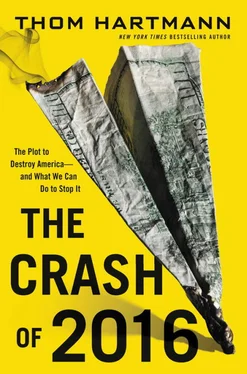Rifkin said in 2012, “When oil hit $147 a barrel on world markets,” then “the other prices across the supply chain went through the roof because so much in this civilization is made out of fossil fuels.”
The effects were catastrophic.
“We had food riots in twenty-two countries,” Rifkin said. “The price on basic commodities, rice, wheat, and other basic foodstuffs was doubling and tripling. We had a billion people in harm’s way in terms of hunger and starvation. People stopped buying everywhere.”
Finally, Rifkin argued, “The entire economic engine—the growing economy—shut down, and purchasing went plummeting… that was an economic earthquake. The collapse of the financial market sixty days later—that was the aftershock.” 168
As oil becomes more and more scarce, and developing economies such as China and India demand more and more oil, then the prices will inevitably increase, producing a vicious cycle of oil shocks every time the world economy starts to grow again.
Rifkin notes, “[W]ithin the last ten years, China and India made a bid to bring a third of the human race into a second industrial revolution. The aggregate demand was so great, it dramatically spiked prices for oil. All the other goods and services went up, and per capita purchasing powers shut down.
“This is an endgame,” Rifkin says. Referring to the coming oil-shock cycles, he adds, “Every time we try to restart the economy at the same rate it was growing before July 2008, this process repeats itself… [When] India and China started moving, Europe and America started moving, and immediately oil prices shot up over a hundred [dollars] a barrel, all the other prices went up, and purchasing power shut down again.
“We’re likely to see these gyration cycles: wild gyration cycles of four to five years of growth and then collapse,” Rifkin added.
To protect our supplies of oil around the world, the United States has built up an enormous military, which could get dragged into the Great Crash scenario.
The father of our Constitution and fourth president of the United States, James Madison, would be horrified. He knew just how dangerous never-ending war is to a nation.
“Of all the enemies of true liberty, war is, perhaps, the most to be dreaded, because it comprises and develops the germ of every other,” wrote Madison in 1795. 169
“No nation could preserve its freedom in the midst of continual warfare,” he concluded. [3]
Yet, after Jimmy Carter’s four years of relative peace, every single American president has started his own military conflict: Reagan invaded Grenada, Bush senior went to war against Iraq, Clinton launched strikes against Kosovo and Iraq. And we know well of Bush junior’s military exploits. All the while the mansions belonging to defense contractors that ring Washington, DC—making the DC suburbs the most affluent zip codes in the nation—just kept adding more and more floors and wings, while missile makers and private-security CEOs became multimillionaire war profiteers.
Today, our military is scattered across the Arab world, throwing trillions of dollars into known and unknown wars in Afghanistan, Iraq, Yemen, Libya, Somalia, Pakistan, and who-knows-where-else. These military misadventures have swelled the Pentagon budget to nearly half the entire federal budget: Fifty cents of every single dollar you pay in taxes goes to war.
And you can see the damage of war, not just in our economy but also in the broken spirits and traumatized minds of the soldiers we send off to tour after tour of military duty in some of the most violent regions of the world. Thousands are coming back to the United States every year maimed both physically and mentally. In 2012, a record number of men and women in our armed forces committed suicide. 170
The burdens of war also manifest themselves in atrocities in the theaters of war—from service members going rogue and joining “kill squads,” to institutionalized torture in military prisons such as Abu Ghraib and Gitmo, to the desecration of enemy bodies.
Even the most powerful men in our nation have been seduced by war. On television and in their memoirs, both President George W. Bush and Vice President Dick Cheney confessed to authorizing “enhanced interrogation” such as waterboarding, which is considered a form of torture under international law. The most frightening part about all of this militarism is if we were to instantly scale our military back to where it was in 1997—with one-third the budget it has today—our economy would disintegrate. We’ve made such a Faustian deal with the Gods of War that our economic survival, at least over the short term, depends on continually feeding the war machine.
And feed it well we have. Between 1997 and 2012, our “defense” budget tripled .
The double whammy of this is that when our manufacturing base is military, we produce things that don’t produce any lasting benefit for our society.
When we build a school or a bridge or a high-speed rail system, years, decades, sometimes even centuries of use and value come from it. They produce for us, over time, far more than they cost us. Even consumer goods—from homes to washing machines to computers—increase our personal ability to be productive, thus producing a return on investment (albeit not so visible in GDP as are infrastructure investments).
But when we spend $100 million on a bunker-buster bomb, and that bomb is dropped somewhere, that $100 million just went up in smoke, never to be seen again. As the Romans and the Soviets and so many other empires before ours have found out, military spending is the least productive and sustainable way to build an economy.
In fact, a quick inspection of previous world superpowers reveals that they all met their demise by economic collapse following binges of military adventurism—often after a desperate campaign was launched to protect the last vestiges of their empire.
It’s what happened to the Romans and it’s also what happened to the Soviet Union, the last great economic superpower to collapse. After a nine-year military quagmire in Afghanistan, the Soviets found themselves so drained of resources that they had to withdraw their troops to tend to their own collapsing economy. Only a few years after the Afghan war, as Osama Bin Laden proudly proclaimed, the Soviet Union was in full meltdown.
We didn’t get the memo. And today, at the behest of the Royalists, our nation is still fighting a more-than-decade-long war in Afghanistan that’s producing the same empire-destroying consequences that befell the Soviet Union.
So, what does the United States look like when one, or all, of these shocks converge by 2016, or sooner?
Well, to begin with, whatever cash the major banks and corporations have stashed away heading into the Great Crash won’t be nearly enough to cover the subsequent losses that come with the collapse of the global banking system.
According to the Bank of International Settlements, the global derivatives market is now $1.2 quadrillion, or $1,200 trillion.
As economist Steve Keen explains in chapter 6, the financial sector inherently wants to produce more and more debt in an economy, since its primary way of making profit is through interest on that debt and fees to service that debt.
The financial sector received a huge stimulus when, thanks to Reaganomics, working people’s wages stopped growing even as productivity and inflation increased.
As a result of declining wages, the only way the middle class could maintain their American lifestyle was by taking on loads and loads of debt in the form of home mortgages, credit card loans, and student loans.
Читать дальше












